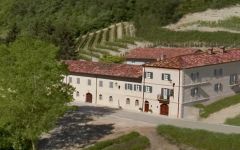Marcarini Barolo Brunate (375ML half-bottle) 2011
-
James
Suckling -
Wine
Enthusiast -
Wine &
Spirits -
Wine
Spectator -
Robert
Parker


Product Details
Your Rating
Somm Note
Winemaker Notes
Professional Ratings
-
James Suckling
A rich and flavorful red with plum, dried orange peel and a chocolate finish. Full body, round tannins and a savory finish. Better in 2018.
-
Wine Enthusiast
Berry steeped in spirits, baking spice and chopped herb aromas lead the nose. The young, bracing palate offers raw red berry, white pepper, clove, mint and grilled sage accompanied by youthfully assertive tannins and bright acidity. Give it time to soften and open up. Drink 2019–2026.
-
Wine & Spirits
Ripe red plum flavors and vibrant acidity surge through this 2011, accented by notes of tobacco, cola, and black spice, lifted by aromas of rose petals and herbs. Fruit-skin tannins tighten the finish, but this is enjoyable now if decanted and served with a porcini mushroom risotto.
-
Wine Spectator
Graphite, dried cherry, tar, licorice, spice and menthol flavors combine here. In the end, the beefy tannins will require some time to integrate. A traditional style. Best from 2019 through 2033.
-
Robert Parker's Wine Advocate
The hot-vintage 2011 Barolo Brunate is not at the top of its game, but it does deliver plenty of dark fruit and succulent spice. I did like this wine better than the Barolo La Serra in this vintage.
Other Vintages
2018-
James
Suckling
-
James
Suckling -
Wine
Enthusiast -
Wine &
Spirits
-
Wine
Enthusiast -
Wine
Spectator
-
Wine
Enthusiast -
James
Suckling -
Wine &
Spirits -
Wine
Spectator
-
Wine
Spectator - Decanter
-
Wine
Enthusiast
-
Wine
Enthusiast -
Wine
Spectator
-
Wine
Spectator -
Wine
Enthusiast -
James
Suckling -
Robert
Parker
-
Robert
Parker -
Wine
Enthusiast -
Wine
Spectator
-
Robert
Parker
-
Wine
Enthusiast -
Robert
Parker
-
Robert
Parker
-
Wine
Spectator
-
Wine
Spectator
-
Wine
Spectator




Luisa & Manuel Marchetti have been in charge of Luisa's family winery since 1990, with Manuel responsible for sales & promotions, Luisa orchestrating the wines with consultant oenologist Armando Cordero. Founded by Luisa's great-great-great-grandfather, the estate was one of the very first in the area to designate single vineyards on its labels as early as 1950. The property covers 62 acres, 42 of which are under vine. In fact, one of Marcarini's superb, historical crus is 150-year-old Boschi di Berri, whose Dolcetto vines are among the oldest in Italy, having survived Phylloxera and maintained indigenous rootstock. The Marchettis' varietal map (except the Shiraz) is almost exclusively native to the Langhe hills. The Nebbiolo grapes for Barolo are grown within the estate's original nucleus, high on the rolling terroir of La Morra: two celebrated, contiguous crus, Brunate and La Serra. The building itself (adjoining a medieval tower) goes back to the 1700s: the cool, ancient underground cellars provide an ideal environment for the wines’ classic élevage. The exceptional vineyards – all estate-owned – are the true heart of the winery. The superb locations, steepness of the slopes and nature of the terrain, exposure to the sunlight, exceptional microclimate, are not only conducive to top wines, but to non-aggressive, natural vineyard management.

Responsible for some of the most elegant and age-worthy wines in the world, Nebbiolo, named for the ubiquitous autumnal fog (called nebbia in Italian), is the star variety of northern Italy’s Piedmont region. Grown throughout the area, as well as in the neighboring Valle d’Aosta and Valtellina, it reaches its highest potential in the Piedmontese villages of Barolo, Barbaresco and Roero. Outside of Italy, growers are still very much in the experimentation stage but some success has been achieved in parts of California. Somm Secret—If you’re new to Nebbiolo, start with a charming, wallet-friendly, early-drinking Langhe Nebbiolo or Nebbiolo d'Alba.

The center of the production of the world’s most exclusive and age-worthy red wines made from Nebbiolo, the Barolo wine region includes five core townships: La Morra, Monforte d’Alba, Serralunga d’Alba, Castiglione Falletto and the Barolo village itself, as well as a few outlying villages. The landscape of Barolo, characterized by prominent and castle-topped hills, is full of history and romance centered on the Nebbiolo grape. Its wines, with the signature “tar and roses” aromas, have a deceptively light garnet color but full presence on the palate and plenty of tannins and acidity. In a well-made Barolo wine, one can expect to find complexity and good evolution with notes of, for example, strawberry, cherry, plum, leather, truffle, anise, fresh and dried herbs, tobacco and violets.
There are two predominant soil types here, which distinguish Barolo from the lesser surrounding areas. Compact and fertile Tortonian sandy marls define the vineyards farthest west and at higher elevations. Typically the Barolo wines coming from this side, from La Morra and Barolo, can be approachable relatively early on in their evolution and represent the “feminine” side of Barolo, often closer in style to Barbaresco with elegant perfume and fresh fruit.
On the eastern side of the Barolo wine region, Helvetian soils of compressed sandstone and chalks are less fertile, producing wines with intense body, power and structured tannins. This more “masculine” style comes from Monforte d’Alba and Serralunga d’Alba. The township of Castiglione Falletto covers a spine with both soil types.
The best Barolo wines need 10-15 years before they are ready to drink, and can further age for several decades.
